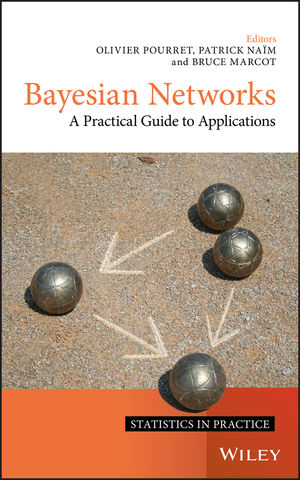Bayesian Networks: A Practical Guide to ApplicationsISBN: 978-0-470-06030-8
Hardcover
446 pages
March 2008
 Other Available Formats: E-book
|
||||||
Foreword ix
Preface xi
1 Introduction to Bayesian networks 1
1.1 Models 1
1.2 Probabilistic vs. deterministic models 5
1.3 Unconditional and conditional independence 9
1.4 Bayesian networks 11
2 Medical diagnosis 15
2.1 Bayesian networks in medicine 15
2.2 Context and history 17
2.3 Model construction 19
2.4 Inference 26
2.5 Model validation 28
2.6 Model use 30
2.7 Comparison to other approaches 31
2.8 Conclusions and perspectives 32
3 Clinical decision support 33
3.1 Introduction 33
3.2 Models and methodology 34
3.3 The Busselton network 35
3.4 The PROCAM network 40
3.5 The PROCAM Busselton network 44
3.6 Evaluation 46
3.7 The clinical support tool: TakeHeartII 47
3.8 Conclusion 51
4 Complex genetic models 53
4.1 Introduction 53
4.2 Historical perspectives 54
4.3 Complex traits 56
4.4 Bayesian networks to dissect complex traits 59
4.5 Applications 64
4.6 Future challenges 71
5 Crime risk factors analysis 73
5.1 Introduction 73
5.2 Analysis of the factors affecting crime risk 74
5.3 Expert probabilities elicitation 75
5.4 Data preprocessing 76
5.5 A Bayesian network model 78
5.6 Results 80
5.7 Accuracy assessment 83
5.8 Conclusions 84
6 Spatial dynamics in France 87
6.1 Introduction 87
6.2 An indicator-based analysis 89
6.3 The Bayesian network model 97
6.4 Conclusions 109
7 Inference problems in forensic science 113
7.1 Introduction 113
7.2 Building Bayesian networks for inference 116
7.3 Applications of Bayesian networks in forensic science 120
7.4 Conclusions 126
8 Conservation of marbled murrelets in British Columbia 127
8.1 Context/history 127
8.2 Model construction 129
8.3 Model calibration, validation and use 136
8.4 Conclusions/perspectives 147
9 Classifiers for modeling of mineral potential 149
9.1 Mineral potential mapping 149
9.2 Classifiers for mineral potential mapping 151
9.3 Bayesian network mapping of base metal deposit 157
9.4 Discussion 166
9.5 Conclusions 171
10 Student modeling 173
10.1 Introduction 173
10.2 Probabilistic relational models 175
10.3 Probabilistic relational student model 176
10.4 Case study 180
10.5 Experimental evaluation 182
10.6 Conclusions and future directions 185
11 Sensor validation 187
11.1 Introduction 187
11.2 The problem of sensor validation 188
11.3 Sensor validation algorithm 191
11.4 Gas turbines 197
11.5 Models learned and experimentation 198
11.6 Discussion and conclusion 202
12 An information retrieval system 203
12.1 Introduction 203
12.2 Overview 205
12.3 Bayesian networks and information retrieval 206
12.4 Theoretical foundations 207
12.5 Building the information retrieval system 215
12.6 Conclusion 223
13 Reliability analysis of systems 225
13.1 Introduction 225
13.2 Dynamic fault trees 227
13.3 Dynamic Bayesian networks 228
13.4 A case study: The Hypothetical Sprinkler System 230
13.5 Conclusions 237
14 Terrorism risk management 239
14.1 Introduction 240
14.2 The Risk Influence Network 250
14.3 Software implementation 254
14.4 Site Profiler deployment 259
14.5 Conclusion 261
15 Credit-rating of companies 263
15.1 Introduction 263
15.2 Naive Bayesian classifiers 264
15.3 Example of actual credit-ratings systems 264
15.4 Credit-rating data of Japanese companies 266
15.5 Numerical experiments 267
15.6 Performance comparison of classifiers 273
15.7 Conclusion 276
16 Classification of Chilean wines 279
16.1 Introduction 279
16.2 Experimental setup 281
16.3 Feature extraction methods 285
16.4 Classification results 288
16.5 Conclusions 298
17 Pavement and bridge management 301
17.1 Introduction 301
17.2 Pavement management decisions 302
17.3 Bridge management 307
17.4 Bridge approach embankment – case study 308
17.5 Conclusion 312
18 Complex industrial process operation 313
18.1 Introduction 313
18.2 A methodology for Root Cause Analysis 314
18.3 Pulp and paper application 321
18.4 The ABB Industrial IT platform 325
18.5 Conclusion 326
19 Probability of default for large corporates 329
19.1 Introduction 329
19.2 Model construction 332
19.3 BayesCredit 335
19.4 Model benchmarking 341
19.5 Benefits from technology and software 342
19.6 Conclusion 343
20 Risk management in robotics 345
20.1 Introduction 345
20.2 DeepC 346
20.3 The ADVOCATE II architecture 352
20.4 Model development 354
20.5 Model usage and examples 360
20.6 Benefits from using probabilistic graphical models 361
20.7 Conclusion 362
21 Enhancing Human Cognition 365
21.1 Introduction 365
21.2 Human foreknowledge in everyday settings 366
21.3 Machine foreknowledge 369
21.4 Current application and future research needs 373
21.5 Conclusion 375
22 Conclusion 377
22.1 An artificial intelligence perspective 377
22.2 A rational approach of knowledge 379
22.3 Future challenges 384
Bibliography 385
Index 427



